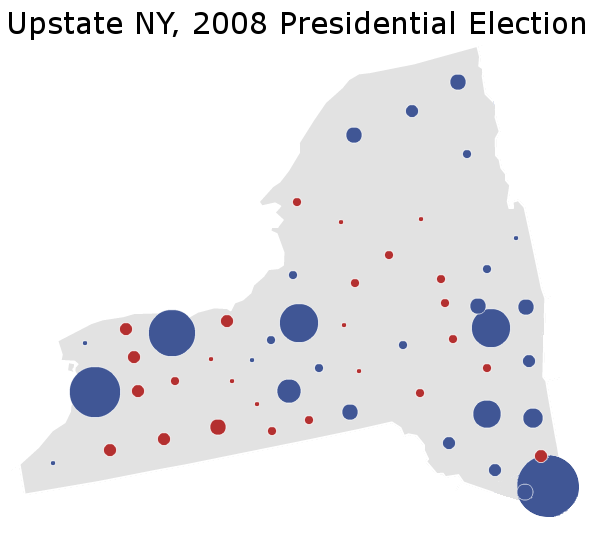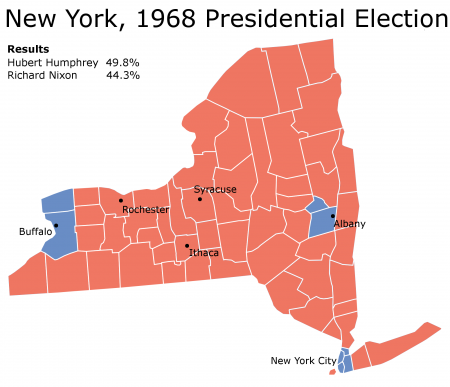This is the first part of two posts analyzing New York’s recent Republican primary. It will focus upon the upstate-downstate divide revealed by the primary. The next part can be found here.
The 2010 Republican Gubernatorial Primary
On September 14th 2010 the Republican Party held its primary in New York. In the gubernatorial primary, party favorite Rick Lazio was defeated by the Tea Party Candidate: businessman Carl Paladino. Mr. Paladino won a comprehensive victory, with 62% of the vote to Mr. Lazio’s 38%.
In the long run, this primary does not matter much – if at all. By next month the primary will all but be forgotten by even the most politically intense folk. Most Americans probably weren’t even aware that there was a primary in the first place.
Yet, whatever its long-term importance, the primary constitutes a valuable tool for exploring New York’s electoral geography. Mr. Paladino’s victory revealed two interesting facts of New York politics. This post will explore the first one.
The Upstate-Downstate Divide
Picture the state of New York, and most Americans will think of a certain city. This fact has long frustrated the many folks who live in upstate New York – which contains more than seven or eight million people, depending on how one defines upstate.
New York state politics have thus been dominated by the divide between upstate and downstate. Upstate generally votes Republican on a local level; downstate votes heavily Democratic. The divide is also apparent in the battle over whether resources are to be spent upstate or in New York City.
On the presidential level, this pattern is relatively hard to discern:
A look at upstate New York in the 2008 presidential election shows President Barack Obama dominating. While downstate New York casts an extremely Democratic ballot, upstate New York also votes for the blue side.
Indeed, Democrats have actually won upstate New York for the past five elections. This table indicates how New York has voted in several recent elections:
Only in 1988 does Governor Mike Dukakis lose the upstate vote, and even then Mr. Dukakis does fairly respectably. (Note: This table includes suburban Westchester and Rockland County as part of upstate; an alternative definition may not do so). Thus, it is somewhat difficult to find a difference between upstate and downstate New York when looking at presidential elections.
This was not the case with New York’s Republican gubernatorial primary. Here is a map of the results:
This is a tremendous regional divide. Upstate New York votes overwhelmingly for Mr. Paladino, while downstate gives Mr. Lazio a strong vote, despite his overall poor performance. Indeed, in Erie County (Buffalo) Mr. Paladino actually got 93% of the vote. On the other hand, Long Island Suffolk County gave his opponent two-thirds of its support.
Not surprisingly, Mr. Paladino’s home is located in Buffalo, while Mr. Lazio represented a congressional district in central Long Island. Mr. Lazio was also born in Suffolk County. His long history with downstate New York led to considerable discontent upstate, and constituted one factor behind its landslide rejection of Mr. Lazio.
There is one final thing that must be noted, however. While Mr. Paladino definitely looks like a winner under the map above, the 3:2 split may look strange to seasoned observers of New York politics. Mr. Lazio, after all, is winning both New York City and its suburbs. Manhattan, Brooklyn, and Queens are supporting him by double-digits – while he is running very strongly in Long Island.
Democrats have won New York with similar maps. Here is one such map:
As it turns out, Mr. Lazio would have indeed done a bit better under general election circumstances. That is, if Mr. Lazio had won the same percent of the vote in each county in the 2008 presidential election, he would have gained 40% of the vote. This is not an enormous change, but in a close election it means the difference between victory and defeat.
This seeming contradiction lies at the heart of another interesting truth that New York’s Republican primary revealed: namely, that Republicans do not exist in New York City. The next post will explore this strange phenomenon.




http://www.theatlantic.com/pol…